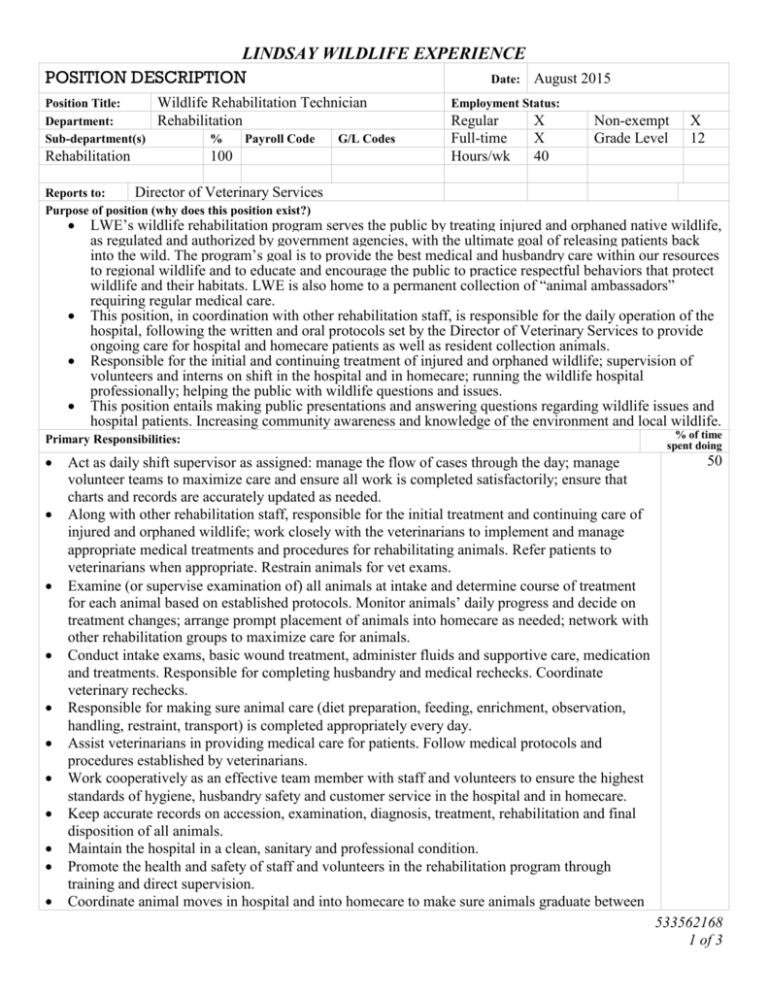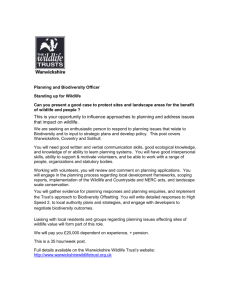Position Description - Lindsay Wildlife Experience
advertisement

LINDSAY WILDLIFE EXPERIENCE POSITION DESCRIPTION Date: August 2015 Position Title: Department: Sub-department(s) Wildlife Rehabilitation Technician Rehabilitation Rehabilitation % Payroll Code 100 G/L Codes Employment Status: Regular Full-time Hours/wk X X 40 Non-exempt Grade Level X 12 Reports to: Director of Veterinary Services Purpose of position (why does this position exist?) LWE’s wildlife rehabilitation program serves the public by treating injured and orphaned native wildlife, as regulated and authorized by government agencies, with the ultimate goal of releasing patients back into the wild. The program’s goal is to provide the best medical and husbandry care within our resources to regional wildlife and to educate and encourage the public to practice respectful behaviors that protect wildlife and their habitats. LWE is also home to a permanent collection of “animal ambassadors” requiring regular medical care. This position, in coordination with other rehabilitation staff, is responsible for the daily operation of the hospital, following the written and oral protocols set by the Director of Veterinary Services to provide ongoing care for hospital and homecare patients as well as resident collection animals. Responsible for the initial and continuing treatment of injured and orphaned wildlife; supervision of volunteers and interns on shift in the hospital and in homecare; running the wildlife hospital professionally; helping the public with wildlife questions and issues. This position entails making public presentations and answering questions regarding wildlife issues and hospital patients. Increasing community awareness and knowledge of the environment and local wildlife. Primary Responsibilities: Act as daily shift supervisor as assigned: manage the flow of cases through the day; manage volunteer teams to maximize care and ensure all work is completed satisfactorily; ensure that charts and records are accurately updated as needed. Along with other rehabilitation staff, responsible for the initial treatment and continuing care of injured and orphaned wildlife; work closely with the veterinarians to implement and manage appropriate medical treatments and procedures for rehabilitating animals. Refer patients to veterinarians when appropriate. Restrain animals for vet exams. Examine (or supervise examination of) all animals at intake and determine course of treatment for each animal based on established protocols. Monitor animals’ daily progress and decide on treatment changes; arrange prompt placement of animals into homecare as needed; network with other rehabilitation groups to maximize care for animals. Conduct intake exams, basic wound treatment, administer fluids and supportive care, medication and treatments. Responsible for completing husbandry and medical rechecks. Coordinate veterinary rechecks. Responsible for making sure animal care (diet preparation, feeding, enrichment, observation, handling, restraint, transport) is completed appropriately every day. Assist veterinarians in providing medical care for patients. Follow medical protocols and procedures established by veterinarians. Work cooperatively as an effective team member with staff and volunteers to ensure the highest standards of hygiene, husbandry safety and customer service in the hospital and in homecare. Keep accurate records on accession, examination, diagnosis, treatment, rehabilitation and final disposition of all animals. Maintain the hospital in a clean, sanitary and professional condition. Promote the health and safety of staff and volunteers in the rehabilitation program through training and direct supervision. Coordinate animal moves in hospital and into homecare to make sure animals graduate between % of time spent doing 50 533562168 1 of 3 LINDSAY WILDLIFE EXPERIENCE enclosures and move through the system appropriately. Assist the hospital manager in coordinating transfers to other centers as needed. Ensure that treatment of all wildlife in our care is executed to the highest achievable level with the assistance of volunteers; supervise assistants, interns and volunteers in hospital and in home care. Provide a high level of customer service to volunteers and coworkers. Maintain professional demeanor and provide respectful and open communication with other staff, volunteers and the public. Support veterinarians—help manage veterinarians’ day, prioritize caseload. Assist with and perform: Anesthesia (induction, intubation, maintenance, recovery, logs); radiographs; wound cleaning and suturing; blood draws; catheter placement; other medical procedures directed by veterinarians. (Note: some tasks are specific for RVTs only) Lab work: Prepare fecals, cytologies, blood (hematocrit/smears); proficiency at reading fecals; ability to read blood smears a plus. Set up and clean up medical procedures. Responsible for cleaning and maintenance of surgical trailer, BTS, diagnostic and surgical equipment. Maintenance of surgical instruments and other sterile pack items. Maintain anesthesia machines—order O2, CO2 and isoflurane as needed. Manage inventory and ordering of medical supplies. Manage donated medical supplies. Maintain controlled drug log. Manage sharps containers and drug disposal. Communicate post-op surgical and medical care to collection keepers, rehabilitation techs, hospital manager and volunteers as needed to facilitate care. Provide training to hospital and collection staff as directed by vet on basic medical aspects of patient care. Answer phone calls; help public with wildlife issues and questions. Provide a high level of customer service and education to the public on the phone and at the accession desk. 35 5 Present daily Behind the Scenes (BTS) presentations that highlight the work of the hospital. Work with animal encounters/museum interpreters to make sure the BTS message reflects the LWE’s mission. 5 Participate in the training of substitute rehabilitation technicians, assistants, volunteers and interns, both initial training and continuing education; update training materials as needed. Assist hospital manager with on-shift training for volunteers. 4 Work with the Director of Veterinary Services to set and implement department and organizational goals. 1 General Description (How would you describe this job to someone who has never done it?): This position is responsible for the daily rehabilitation operation of the hospital, following the written and oral protocols set by the veterinarians to provide ongoing care for hospital and homecare patients. Certain duties may require an RVT license. Working in cooperation with other rehabilitation staff, responsible for the initial and continuing treatment of injured and orphaned wildlife; supervision of volunteers on shift in the hospital and in homecare; running the wildlife hospital professionally; helping the public with wildlife questions and issues. Ensure that good customer service—to volunteers, coworkers, the public and the patients—is consistently given. In addition, rehabilitation technicians will fulfill continuing education requirements by attending conferences, seminars, etc. and staying current in the field. Job skills will be periodically evaluated by the Director of Veterinary Services. Training will be provided as needed. 533562168 2 of 3 LINDSAY WILDLIFE EXPERIENCE Qualifications/minimum requirements: This is a physically demanding position. Must be able to lift 40 lbs. and stand on a concrete floor most of an 8–10-hour day. Must have had rabies pre-exposure vaccinations and recent titer check if vaccinated greater than 2 years in the past. Applicants should expect exposure to certain animal allergens normally present in an environment containing mammals, birds, reptiles, and amphibians. Skills needed: o Be able to assess the condition of an animal at intake and during care on a wide variety of species. o Be able to draw blood from animals and perform basic laboratory diagnostic tests. o Be familiar with common drugs used in wildlife medicine and be able to accurately calculate dosages. o Be familiar with husbandry requirements for native wildlife. o Wildlife rehabilitation experience required. Should know the natural history of native species. o Be a good teacher of both skills and general information. o Have great empathy, patience and be able to make difficult decisions. Must work well with staff, volunteers and general public. Be a good team player. Minimum of two years’ experience working in a wildlife rehabilitation program. Must have at least two years’ supervisory experience working with both staff and volunteers. Must be able to work weekends, some evenings and some holidays. Bachelors degree or higher in biology, medicine, or animal sciences is strongly preferred. California RVT license, proficiency in RVT skills, especially those listed above, is strongly preferred. 533562168 3 of 3







